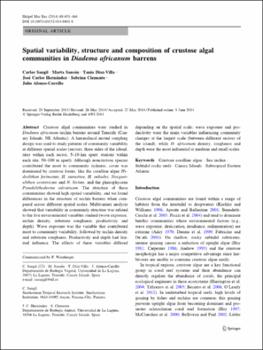Spatial variability, structure and composition of crustose algal communities in Diadema africanum barrens
Fecha
2014Resumen
Crustose algal communities were studied in
Diadema africanum urchin barrens around Tenerife (Canary Islands, NE Atlantic). A hierarchical nested sampling
design was used to study patterns of community variability
at different spatial scales (sectors, three sides of the island;
sites within each sector, 5–10 km apart; stations within
each site, 50–100 m apart). Although noncrustose species
contributed the most to community richness, cover was
dominated by crustose forms, like the coralline algae Hydrolithon farinosum, H. samoe¨nse, H. onkodes, Neogoniolithon orotavicum and N. hirtum, and the phaeophycean
Pseudolithoderma adriaticum. The structure of these
communities showed high spatial variability, and we found
differences in the structure of urchin barrens when compared across different spatial scales. Multivariate analysis
showed that variability in community structure was related
to the five environmental variables studied (wave exposure,
urchin density, substrate roughness, productivity and
depth). Wave exposure was the variable that contributed
most to community variability, followed by urchin density
and substrate roughness. Productivity and depth had limited influence. The effects of these variables differed depending on the spatial scale; wave exposure and productivity were the main variables influencing community
changes at the largest scale (between different sectors of
the island), while D. africanum density, roughness and
depth were the most influential at medium and small scales.






